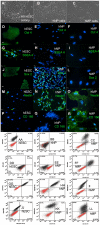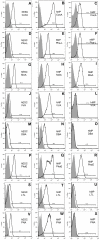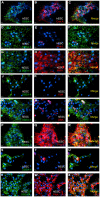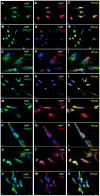Differing lectin binding profiles among human embryonic stem cells and derivatives aid in the isolation of neural progenitor cells
- PMID: 21850265
- PMCID: PMC3151296
- DOI: 10.1371/journal.pone.0023266
Differing lectin binding profiles among human embryonic stem cells and derivatives aid in the isolation of neural progenitor cells
Abstract
Human embryonic stem cells (hESCs) and their differentiated progeny allow for investigation of important changes/events during normal embryonic development. Currently most of the research is focused on proteinacous changes occurring as a result of differentiation of stem cells and little is known about changes in cell surface glycosylation patterns. Identification of cell lineage specific glycans can help in understanding their role in maintenance, proliferation and differentiation. Furthermore, these glycans can serve as markers for isolation of homogenous populations of cells. Using a panel of eight biotinylated lectins, the glycan expression of hESCs, hESCs-derived human neural progenitors (hNP) cells, and hESCs-derived mesenchymal progenitor (hMP) cells was investigated. Our goal was to identify glycans that are unique for hNP cells and use the corresponding lectins for cell isolation. Flow cytometry and immunocytochemistry were used to determine expression and localization of glycans, respectively, in each cell type. These results show that the glycan expression changes upon differentiation of hESCs and is different for neural and mesenchymal lineage. For example, binding of PHA-L lectin is low in hESCs (14±4.4%) but significantly higher in differentiated hNP cells (99±0.4%) and hMP cells (90±3%). Three lectins: VVA, DBA and LTL have low binding in hESCs and hMP cells, but significantly higher binding in hNP cells. Finally, VVA lectin binding was used to isolate hNP cells from a mixed population of hESCs, hNP cells and hMP cells. This is the first report that compares glycan expression across these human stem cell lineages and identifies significant differences. Also, this is the first study that uses VVA lectin for isolation for human neural progenitor cells.
Conflict of interest statement
Figures







Similar articles
-
Lectin binding profiles of SSEA-4 enriched, pluripotent human embryonic stem cell surfaces.BMC Dev Biol. 2005 Jul 21;5:15. doi: 10.1186/1471-213X-5-15. BMC Dev Biol. 2005. PMID: 16033656 Free PMC article.
-
Cell surface markers in human embryonic stem cells.Methods Mol Biol. 2007;407:51-61. doi: 10.1007/978-1-59745-536-7_5. Methods Mol Biol. 2007. PMID: 18453248
-
CD marker expression profiles of human embryonic stem cells and their neural derivatives, determined using flow-cytometric analysis, reveal a novel CD marker for exclusion of pluripotent stem cells.Stem Cell Res. 2009 Mar;2(2):113-24. doi: 10.1016/j.scr.2008.08.001. Epub 2008 Sep 16. Stem Cell Res. 2009. PMID: 19383417
-
The production and directed differentiation of human embryonic stem cells.Endocr Rev. 2006 Apr;27(2):208-19. doi: 10.1210/er.2005-0016. Epub 2006 Jan 24. Endocr Rev. 2006. PMID: 16434509 Review.
-
The glycans of stem cells.Curr Opin Chem Biol. 2007 Aug;11(4):373-80. doi: 10.1016/j.cbpa.2007.05.032. Epub 2007 Jul 27. Curr Opin Chem Biol. 2007. PMID: 17681848 Free PMC article. Review.
Cited by
-
Lectin-Based Characterization of Vascular Cell Microparticle Glycocalyx.PLoS One. 2015 Aug 14;10(8):e0135533. doi: 10.1371/journal.pone.0135533. eCollection 2015. PLoS One. 2015. PMID: 26274589 Free PMC article.
-
Mass Spectrometry-Based Glycoproteomic Workflows for Cancer Biomarker Discovery.Technol Cancer Res Treat. 2023 Jan-Dec;22:15330338221148811. doi: 10.1177/15330338221148811. Technol Cancer Res Treat. 2023. PMID: 36740994 Free PMC article. Review.
-
Bladder Cancer Cells Interaction with Lectin-Coated Surfaces under Static and Flow Conditions.Int J Mol Sci. 2023 May 4;24(9):8213. doi: 10.3390/ijms24098213. Int J Mol Sci. 2023. PMID: 37175920 Free PMC article.
-
Glycan Profiling Shows Unvaried N-Glycomes in MSC Clones with Distinct Differentiation Potentials.Front Cell Dev Biol. 2016 May 31;4:52. doi: 10.3389/fcell.2016.00052. eCollection 2016. Front Cell Dev Biol. 2016. PMID: 27303666 Free PMC article.
-
The Blessed Union of Glycobiology and Immunology: A Marriage That Worked.Medicines (Basel). 2023 Jan 19;10(2):15. doi: 10.3390/medicines10020015. Medicines (Basel). 2023. PMID: 36827215 Free PMC article. Review.
References
-
- Shin S, Mitalipova M, Noggle S, Tibbitts D, Venable A, et al. Long-term proliferation of human embryonic stem cell-derived neuroepithelial cells using defined adherent culture conditions. Stem Cells. 2006;24(1):125–38. - PubMed
-
- Bain G, Ray WJ, Yao M, Gottlieb DI. Retinoic acid promotes neural and represses mesodermal gene expression in mouse embryonic stem cells in culture. Biochem Biophys Res Commun. 1996;223(3):691–4. - PubMed
-
- Mujtaba T, Piper DR, Kalyani A, Groves AK, Lucero MT, et al. Lineage-restricted neural precursors can be isolated from both the mouse neural tube and cultured ES cells. Dev Biol. 1999;214(1):113–27. - PubMed
-
- Muraglia A, Cancedda R, Quarto R. Clonal mesenchymal progenitors from human bone marrow differentiate in vitro according to a hierarchical model. J Cell Sci. 2000;113(Pt 7):1161–6. - PubMed
Publication types
MeSH terms
Substances
LinkOut - more resources
Full Text Sources
Other Literature Sources
Medical

